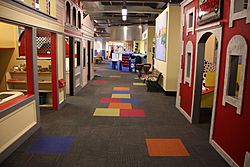Children's Museum at Holyoke facts for kids
 |
|

A miniature cityscape exhibit, including a make-believe supermarket (left), and fire station (right)
|
|
| Lua error in Module:Location_map at line 420: attempt to index field 'wikibase' (a nil value). | |
| Former name | Holyoke Children's Museum |
|---|---|
| Established | 1981 |
| Location | 444 Dwight Street, Holyoke, MA 01040 |
| Type | Children's museum |
| Accreditation | Association of Children's Museums |
| Founder | Junior League of Holyoke |
| Public transit access | Bus: PVTA B23, P20, P21, P21E, R24, R29, X90 (all |
| Nearest parking |
|
The Children's Museum at Holyoke is a special place in Holyoke, Massachusetts. It's a children's museum where kids can learn and play. The museum has many hands-on exhibits. You can explore art, science, and everyday life. There is also a fun climbing area. The museum is in Downtown Holyoke. It is part of the Holyoke Heritage State Park. The building used to be a silk mill.
Contents
History of the Museum
How the Museum Started
The Children's Museum at Holyoke began as a special project. It was started by a group called the Junior League of Holyoke. This group is now known as the Holyoke-Chicopee-Springfield Head Start.
In 1980, a big fire destroyed a mill complex. This mill was next to Holyoke City Hall. After the fire, a government department started planning a new state park. This park was part of a program to create "Heritage Parks." The Junior League wanted a children's museum to be part of this new park.
Early Days and First Location
To test their idea, the Junior League opened a small version of the museum. It opened on September 27, 1981. This first museum was in a renovated storefront. It was located at 171 High Street. The idea for this museum came from the Boston Children's Museum.
The first version had four main areas. There was a pretend firetruck built by a local carpenter. There was also a mock post office. Kids could also make their own paper sheets. This was part of a paper mill exhibit. A small print shop was also available.
Moving to a Permanent Home
The pilot museum was a big success. The next year, the museum moved to its first permanent home. This was at 15 Papineau Street, in the old Springdale School.
In its early years, the museum tried many different exhibits. Some exhibits helped kids understand and care about people with disabilities. For example, in 1983, there was a temporary exhibit. Kids could try to tie their shoes with oversized gloves. They could also ride different wheelchairs. They even tried to read in braille and solve puzzles while blindfolded.
Other exhibits included an animal area. Kids could meet hamsters, rabbits, and other pets. These pets were loaned by a local pet store. The museum also showed how seeing-eye and hearing dogs are trained. The museum also celebrated different cultures. They had events like cooking demonstrations for Indian food. They also featured Irish dancing.
Becoming an Independent Museum
On August 9, 1984, the museum became its own nonprofit group. It was officially named Children's Museum at Holyoke, Inc.
The museum finally began moving to Holyoke Heritage State Park. A special ceremony was held on November 9, 1985. This was to start the renovation of the Sheldon Building. This building used to be a storage area for the Skinner Silk Mills.
Almost two years later, on June 5, 1987, a ribbon-cutting ceremony took place. The Volleyball Hall of Fame also opened in the same building. The Children's Museum at Holyoke opened to visitors the next day.
Museum Exhibits
The museum has more than 20 permanent exhibits. These are for toddlers and older children. Some of the fun exhibits include:
- Art Studio
- Curvy Climber/ Curvy Crawler
- Ambulance
- Forklift
- Grocery Store
- Paw and Play
- Fire Truck
- Kitchen and Diner
- Automotive Technician's Center
- Light Bright Wall
- Rooftop Garden
- Puppet Theater
- Tile Table
- World of Motion
- Tot Lot
- Water Table
- Air Maze
Special Events
First Night Jr.
- First Night Jr. is held every year on December 31. It has been happening since 1997. This event is done with the Holyoke Merry-Go-Round. It usually features ice sculptures. There are also many family-friendly activities. These take place in the afternoon on New Year's Eve.
Sensory Sundays
- *Currently inactive* Sensory Sundays started in October 2019. These special days were for children on the autism spectrum. They were also for kids with sensory processing disorder. On these Sundays, the museum would dim the lights. They would also turn off sounds on louder exhibits. The replica ambulance, for example, would be quieter.
See also


